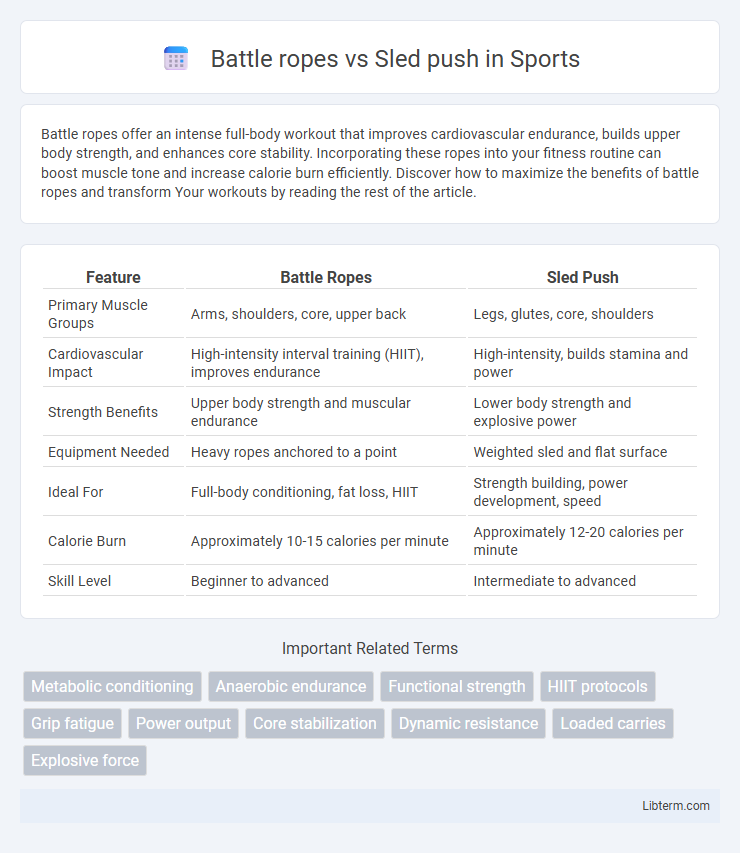Battle ropes offer an intense full-body workout that improves cardiovascular endurance, builds upper body strength, and enhances core stability. Incorporating these ropes into your fitness routine can boost muscle tone and increase calorie burn efficiently. Discover how to maximize the benefits of battle ropes and transform Your workouts by reading the rest of the article.
Table of Comparison
| Feature | Battle Ropes | Sled Push |
|---|---|---|
| Primary Muscle Groups | Arms, shoulders, core, upper back | Legs, glutes, core, shoulders |
| Cardiovascular Impact | High-intensity interval training (HIIT), improves endurance | High-intensity, builds stamina and power |
| Strength Benefits | Upper body strength and muscular endurance | Lower body strength and explosive power |
| Equipment Needed | Heavy ropes anchored to a point | Weighted sled and flat surface |
| Ideal For | Full-body conditioning, fat loss, HIIT | Strength building, power development, speed |
| Calorie Burn | Approximately 10-15 calories per minute | Approximately 12-20 calories per minute |
| Skill Level | Beginner to advanced | Intermediate to advanced |
Introduction to Battle Ropes and Sled Push
Battle ropes engage multiple muscle groups through dynamic, high-intensity waves that enhance cardiovascular endurance and upper body strength. Sled push targets lower body power and explosive strength by requiring maximum force production while driving a weighted sled over a set distance. Both tools deliver functional training benefits, but battle ropes emphasize upper body endurance and core stability, whereas sled pushes develop lower body muscle power and anaerobic capacity.
Key Differences Between Battle Ropes and Sled Push
Battle ropes primarily target upper body endurance and explosive power by engaging muscles in the arms, shoulders, and core through dynamic, wave-like motions, while sled push emphasizes lower body strength, particularly in the glutes, quads, and hamstrings, by requiring forceful leg drive during the pushing motion. Battle ropes offer high-intensity cardiovascular benefits with rhythmic, repetitive movements, whereas sled push combines strength conditioning with anaerobic endurance as athletes exert maximal force against resistance over short distances. The differing mechanics of battle ropes and sled push create unique training stimuli, making battle ropes ideal for improving muscular endurance and metabolic conditioning, and sled push more effective for building raw power and functional strength.
Muscle Groups Targeted
Battle ropes primarily target the upper body muscle groups, including the shoulders, arms, chest, and upper back, while also engaging the core for stability during intense waves and slams. The sled push exercises the lower body muscles intensely, focusing on the quadriceps, hamstrings, glutes, and calves, with additional core involvement for balance and force generation. Both exercises complement each other by challenging different muscle groups, making them effective for full-body strength and conditioning.
Cardiovascular vs Strength Benefits
Battle ropes primarily enhance cardiovascular endurance by maintaining high-intensity, full-body motion that elevates heart rate and improves aerobic capacity. Sled pushing, on the other hand, significantly develops muscular strength and power, particularly targeting the lower body muscles such as the quadriceps, glutes, and hamstrings through resisted movement. While battle ropes optimize cardiovascular conditioning and upper body muscle endurance, sled pushing builds explosive strength and anaerobic capacity in the lower body.
Calorie Burn and Fat Loss Comparison
Battle ropes typically burn around 10-15 calories per minute, engaging multiple muscle groups and promoting high-intensity fat loss through interval training. In contrast, sled push exercises burn approximately 8-12 calories per minute by combining strength and anaerobic conditioning, effectively targeting lower body muscles and boosting metabolism for sustained calorie burn. Both workouts enhance fat loss, but battle ropes may offer higher calorie expenditure in shorter durations due to continuous upper and lower body engagement.
Equipment and Space Requirements
Battle ropes require minimal equipment, consisting of heavy, durable ropes anchored to a fixed point, making them suitable for small workout areas or home gyms. Sled pushes demand more specialized equipment--a weighted sled and a flat, spacious surface such as a turf or gym floor--to accommodate pushing movements with adequate room for distance. The spatial footprint for sled pushes is significantly larger than battle ropes, influencing equipment choice based on available workout space.
Suitability for Fitness Levels
Battle ropes offer adjustable intensity through variations in wave speed and duration, making them suitable for all fitness levels including beginners seeking low-impact cardio and advanced users looking for high-intensity interval training. The sled push requires significant lower body strength and cardiovascular endurance, generally favoring intermediate to advanced individuals with proper form and conditioning to avoid injury. Both exercises can be modified to fit individual capabilities, but sled pushes typically demand a higher baseline of strength and technique.
Injury Risk and Safety Considerations
Battle ropes present a lower injury risk compared to sled pushes due to their low-impact, controlled motion that reduces joint strain and musculoskeletal stress. Sled pushes involve high-intensity, weight-loaded movements that increase the risk of lower back, knee, and shoulder injuries, especially if performed with improper form or excessive load. Prioritizing proper technique, gradual load progression, and adequate warm-up are essential for safety in both exercises.
Incorporating Battle Ropes and Sled Push in Workouts
Incorporating battle ropes and sled push into workouts enhances full-body conditioning and muscular endurance by targeting both upper and lower body muscles. Battle ropes improve grip strength, explosive power, and cardiovascular capacity, while sled pushes focus on lower body strength, core stability, and anaerobic endurance. Combining these tools in high-intensity circuit training accelerates fat loss, boosts metabolic rate, and improves functional fitness for athletes and fitness enthusiasts.
Which is Better: Battle Ropes or Sled Push?
Battle ropes offer a dynamic upper-body workout that enhances muscular endurance and cardiovascular fitness through high-intensity, explosive movements. The sled push emphasizes full-body strength, particularly targeting the lower body, core stability, and power development by requiring sustained force against resistance. Choosing between battle ropes and sled push depends on specific fitness goals: battle ropes excel for cardio and arm conditioning, while sled pushes are superior for building raw strength and functional power.
Battle ropes Infographic

 libterm.com
libterm.com